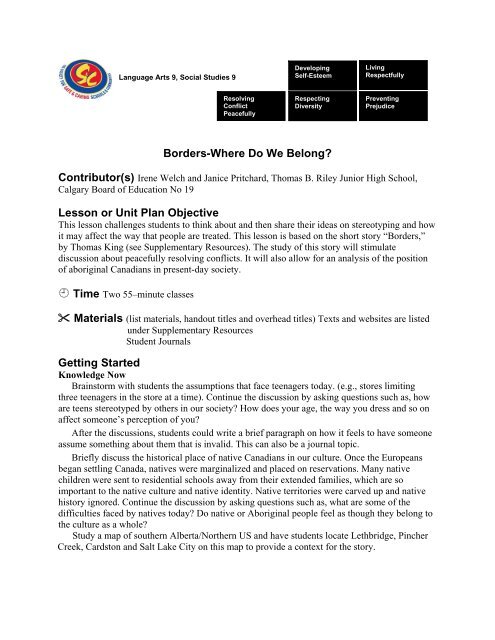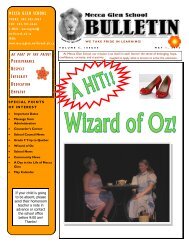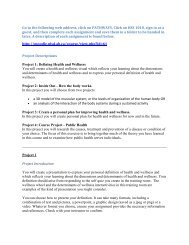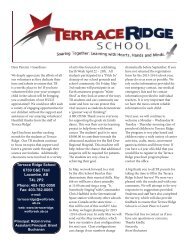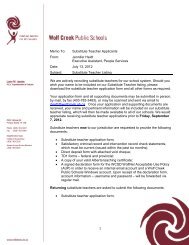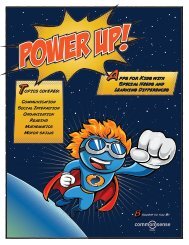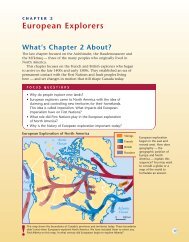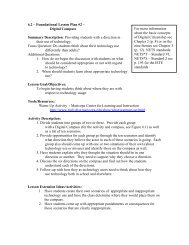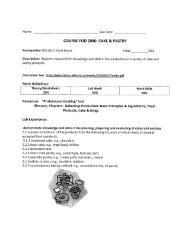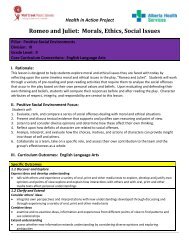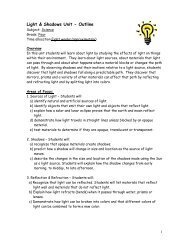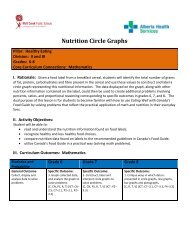Borders-Where Do We Belong? - Wolf Creek Public Schools
Borders-Where Do We Belong? - Wolf Creek Public Schools
Borders-Where Do We Belong? - Wolf Creek Public Schools
- No tags were found...
You also want an ePaper? Increase the reach of your titles
YUMPU automatically turns print PDFs into web optimized ePapers that Google loves.
Language Arts 9, Social Studies 9DevelopingSelf-EsteemLivingRespectfullyResolvingConflictPeacefullyRespectingDiversityPreventingPrejudice<strong>Borders</strong>-<strong>Where</strong> <strong>Do</strong> <strong>We</strong> <strong>Belong</strong>?Contributor(s) Irene <strong>We</strong>lch and Janice Pritchard, Thomas B. Riley Junior High School,Calgary Board of Education No 19Lesson or Unit Plan ObjectiveThis lesson challenges students to think about and then share their ideas on stereotyping and howit may affect the way that people are treated. This lesson is based on the short story “<strong>Borders</strong>,”by Thomas King (see Supplementary Resources). The study of this story will stimulatediscussion about peacefully resolving conflicts. It will also allow for an analysis of the positionof aboriginal Canadians in present-day society. Time Two 55–minute classes Materials (list materials, handout titles and overhead titles) Texts and websites are listedunder Supplementary ResourcesStudent JournalsGetting StartedKnowledge NowBrainstorm with students the assumptions that face teenagers today. (e.g., stores limitingthree teenagers in the store at a time). Continue the discussion by asking questions such as, howare teens stereotyped by others in our society? How does your age, the way you dress and so onaffect someone’s perception of you?After the discussions, students could write a brief paragraph on how it feels to have someoneassume something about them that is invalid. This can also be a journal topic.Briefly discuss the historical place of native Canadians in our culture. Once the Europeansbegan settling Canada, natives were marginalized and placed on reservations. Many nativechildren were sent to residential schools away from their extended families, which are soimportant to the native culture and native identity. Native territories were carved up and nativehistory ignored. Continue the discussion by asking questions such as, what are some of thedifficulties faced by natives today? <strong>Do</strong> native or Aboriginal people feel as though they belong tothe culture as a whole?Study a map of southern Alberta/Northern US and have students locate Lethbridge, Pincher<strong>Creek</strong>, Cardston and Salt Lake City on this map to provide a context for the story.
Engaging InterestDiscuss stereotyping in general. This could be done as a think-pair-share. How are teens thevictim of stereotypes? What about older people? What assumptions do students make aboutsenior citizens?Brainstorm with students the process of crossing a border. What is the procedure? Why is thisprocedure followed?Learning Activities1. After the discussion above, read the story “<strong>Borders</strong>” to the class up to the middle of page51.2. Stop and have students write predictions of what could happen as the characters reach theborder.3. Finish reading the story.4. Students will create two journal entries: one from the mother’s perspective the other fromthe border guard’s perspective.5. As a class, discuss the conflict in the story. Why does it arise? How is it resolved?6. Class discussion: Given that the Americans have now passed legislation saying anyonewanting to enter the USA MUST have a passport, what will the implications be for ourcharacters? <strong>Do</strong> you think they will go and apply for a passport? Why or not?7. Assignment: Create a plot diagram, indicating initial incident, rising action, climax anddenouement.8. Form groups of two students and ask them to list situations around the world that havehad positive or negative solutionsAssessment/AnalysisInformal assessmentIn pairs, students brainstorm other ways the conflict in the story could have ended. Whatwere the possible outcomes? Have them share their ideas in a whole class setting.Formal AssessmentStudents will be assessed through their journal entries and the plot diagram submitted formarking.Final AssignmentStudents write a letter, in business letter format, to either the American or Canadiangovernment about the incident at the border. Students can take on the role of the story’snarrator, his mother, or any one of the other people who were involved in, or whowitnessed the stand-off. How did this person feel about the treatment of the protagonistsin the story? <strong>Do</strong>es he or she agree with government demanding that natives state anationality? If they disagree, do they have any suggestions of ways to handle the situationin which the protagonists find themselves?ApplicationStudents, in groups of four, plan and role play a situation that could have positive ornegative resolutions, e.g. wearing hats in school, students in 7-11, option classes, schoolclothing rules. Have students come up with alternative endings.After the class presentations, discuss with the class how and when you know that it istime to take a stand on as issue.The Society for Safe and Caring <strong>Schools</strong> and Communities—www.sacsc.ca 2
Activities for Extension and/or Integration• This language arts lesson could be planned to coincide with the Grade 9 social studiescurriculum when discussions arise comparing and contrasting American and Canadianculture.• This lesson can be used in conjunction with the Grade 8 social studies curriculum when thetopic of our native culture is addressed.• The new Grade 7 Social Studies curriculum addresses Aboriginal perspectives. This could beused in a Grade 7 social studies, Grade 7 language arts or Humanities class.• I have followed up this Grade 9 language arts lesson to practise business letter writing.Students may choose any one of the characters and write a letter in business letter format tothe government about the conflict and its resolution.• Another writing assignment would be for students to write an editorial about the incident.• This story is a great introduction to a media awareness unit.Subject and Level Learner Outcomes for Subject and LevelLanguage Arts2.1 Use textual cues and prominent organizational patterns2.1 Analyze and explain connections2.1 Use comprehension strategies2.2 Respond personally and critically to the text1.1 Express ideas2.3 Examine the use of a variety of techniques2.1 Construct and confirm meaning2.3 Understand forms and techniques3.1 Create and follow a planSocial StudiesAddresses issues in the new Grade 7 social studies curriculum.Connecting prior knowledge from Grade 8 social studies curriculum (Canada and NativeStudies) to the study of the USA in Grade 9.Safe and Caring Topics and ConceptsLiving Respectfully• Understanding Conflict, Peace, Justice and ViolenceDeveloping Self-Esteem• Listening with Empathy to Understand the Other Person’s Point of View• Respecting and Celebrating Our Unique IdentitiesRespecting Diversity and Preventing Prejudice• Respecting Different Points of View Builds Community and Helps to Prevent orResolve Conflict.• Stereotypes Limit Our Perception and Understanding of Other People• Stereotyping Leads to Prejudice, Discrimination and Conflict• Respecting Human Rights• Analyzing How Prejudice Can Lead to Conflict and Violence• Recognizing and Appreciating Contributions Made by Culturally DistinctiveGroups Builds Respect for DiversityThe Society for Safe and Caring <strong>Schools</strong> and Communities—www.sacsc.ca 3
Resolving Conflict Peacefully• Resolving Conflicts Through NegotiationTeaching StrategiesCooperative Learning Inquiry Learning Direct InstructionGo towww.sacsc.ca/strategies forstrategy descriptions• Think-Pair-Share• LectureGeneralization andTransferPeer TeachingEmpathy/AffectiveEducationGeneral TeachingActivities/Ideas• Role playing• Tableaux• Journaling• GroupdiscussionSupplementary ResourcesAtlas of World Geography. Rand McNally and Company.King, 1999. “<strong>Borders</strong>.” In Gage Crossroads 9, ed D Saliani and N Morine, 46–56. Toronto:Gage Educational.The Society for Safe and Caring <strong>Schools</strong> and Communities—www.sacsc.ca 4


